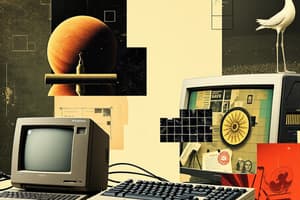Podcast
Questions and Answers
What primary function distinguishes a desktop computer from other computing devices?
What primary function distinguishes a desktop computer from other computing devices?
- It can only be used for running basic applications.
- It requires external hardware to function effectively.
- It can run powerful software applications independently for a single user. (correct)
- It operates solely through a touch interface.
Which statement about system memory is most accurate?
Which statement about system memory is most accurate?
- The capacity of system memory is irrelevant to application speed.
- Increased system memory allows for processing large amounts of data more quickly. (correct)
- More system memory decreases the ability to run applications simultaneously.
- System memory primarily affects the capacity of stored data on a hard drive.
What best describes how peripheral devices contribute to a computing system?
What best describes how peripheral devices contribute to a computing system?
- They only serve as input devices without output functionality.
- They are essential for the internal functioning of the computer.
- They connect external components, enabling input and output of information. (correct)
- They determine the operating system used by the computer.
How does a phablet differ from a smartphone and a tablet?
How does a phablet differ from a smartphone and a tablet?
Which statement most accurately reflects the concept of the Internet of Things (IoT)?
Which statement most accurately reflects the concept of the Internet of Things (IoT)?
Which of the following is a home automation category that allows real-time monitoring and control of security systems?
Which of the following is a home automation category that allows real-time monitoring and control of security systems?
What is the main function of the output step in the data processing model?
What is the main function of the output step in the data processing model?
Which of the following types of operating systems requires a user to purchase a license to use?
Which of the following types of operating systems requires a user to purchase a license to use?
What does the term 'ergonomics' primarily focus on in the workplace?
What does the term 'ergonomics' primarily focus on in the workplace?
What condition is characterized by pain caused by repetitive tasks performed over time?
What condition is characterized by pain caused by repetitive tasks performed over time?
Flashcards are hidden until you start studying
Study Notes
Common Computing Devices
- Computing system includes desktop, workstation, laptops, smartphones, and tablets.
- Desktops and workstations are designed for singular user applications, often referred to as workstations.
- System speed is determined by the computer's performance capabilities.
- Increased system memory allows multiple applications to run simultaneously and enhances data processing speed.
- The main storage drive's capacity defines how much data can be retained when the computer is powered off.
- Peripheral devices such as displays, keyboards, and mice are essential for input and output functions.
- Operating systems (OS) serve as the software backbone that instructions for the computer.
Types of Computers
- Laptops combine display, system components, and input/output devices in a portable chassis.
- Smartphones and tablets mimic personal computer functionality and are easily held with one hand.
- Phablets blend features of smartphones and tablets into one device.
- Internet of Things (IoT) refers to interconnected physical objects equipped with electronics and software for network connectivity.
- Home automation systems enable control over devices such as thermostats, security systems, and appliances through apps and voice commands.
Data Processing
- Input refers to data entry via peripheral devices.
- Processing involves writing data to memory and manipulation by the CPU.
- Output is the display of processed data through output devices.
- Storage can occur in various formats like hard disks and optical discs.
Workstation and Mobile Devices
- Workstation PCs are designed to operate in a fixed location.
- Embedded operating systems power devices like ATM machines and industrial systems.
- Firmware provides the critical functions required for hardware interaction.
Operating Systems Overview
- An operating system is essential for system functionality and user interaction.
- Functions include serving as an interface between users and computers, managing applications, ensuring system health, and overseeing data management.
- Numerous operating systems exist, ranging from batch systems that don't directly interact with users to real-time operating systems (RTOS) designed for prompt data processing.
Types of Operating Systems
- Microsoft Windows is the leading commercial OS; Windows 10 debuted in 2015.
- Apple iOS is the operating system for iPhones and iPads.
- Types of OS include:
- Batch Operating Systems
- Multi-Programming Operating Systems
- Multi-Processing Operating Systems, utilizing multiple CPUs for improved throughput.
- Time-Sharing Operating Systems, allowing simultaneous user processes.
Operating System Layers
- Hardware layer impacts system hardware and external devices.
- CPU scheduling organizes process requests in a managed queue.
- Memory management encompasses ROM and RAM processes.
- Process management oversees task execution.
- I/O buffer temporarily stores input/output data from external devices.
Virtualization
- Virtualization allows multiple operating systems to run on a single computer.
- Components of virtualization include the computer itself, hypervisor, and guest OS.
User Programs
- The top operating system layer includes applications and user interfaces, enabling activities like web browsing.
Studying That Suits You
Use AI to generate personalized quizzes and flashcards to suit your learning preferences.




